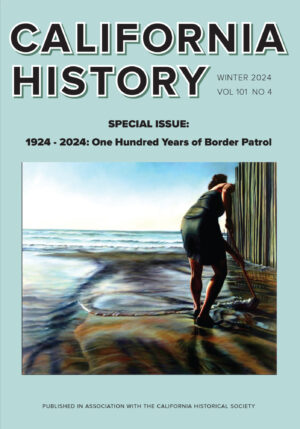"California History" Announces the 2024 Winner of the Richard J. Orsi Prize

California History is pleased to announce the winner of the 2024 Richard J. Orsi Prize. Prize committee members unanimously selected Erica Toffoli’s “Electric Eyes: Surveillance, Sovereignty, and the Limits of the Border Patrol’s Technocratic Vision on the U.S.-Mexico Line” (California History, Vol. 101, No. 4 November [Winter] 2024) as the recipient of the award, which recognizes the best research essay published in the journal annually.
“Electric Eyes” is featured in 1924-2024: One Hundred Years of the Border Patrol, a special issue of California History that commemorates the agency’s centenary. The article mines interviews, memoirs, promotional materials, and archival photographs from the United States Citizenship and Immigration Services History Office and Library to flesh out the intimate links between visuality, surveillance, border policing, and xenophobic nationalism. Amid hysteria over unauthorized migration in the wake of the Bracero Program (1942–1964), the Border Patrol began to represent sovereignty on the U.S.–Mexico line as a visual project. At the same time, it adopted increasingly sophisticated optical devices. To advertise its vigilance, the agency turned to the camera. Via publicity and commemorative projects, the Border Patrol crafted an institutional iconography that showcased its prescient, scientific oversight even as it displayed the U.S.–Mexico boundary’s persistent insecurity. Throughout, it positioned the undocumented as invasive enemies. Ultimately, as “Electric Eyes” demonstrates, the Border Patrol leaned on a visual culture that glorified surveillance to justify the state’s sovereign right to police mobility. Insidiously, it stoked xenophobia by othering Mexican migrants. And it reimagined the U.S.–Mexico border as the site of a forever war: a perpetually vulnerable zone where perfected observation was a required—but never finished—pursuit.
Prize committee members Christopher Capozzola, Carol Lynn McKibben, and Stephen Pitti praise the article’s scope, originality, and engagement with the visual record. Pitti notes that the piece “answered questions I had vaguely thought about (the role of photography from the 1940s forward in defining who undocumented migrants are) and opened ones that hadn’t really occurred to me (how the feds used the medium to represent themselves, their agencies, and the border).” Toffoli, Capozzola explains, “moves deftly as she interprets visual technologies as tools of self-representation for the U.S. government and weapons of surveillance wielded along the border.” Throughout, the article explores “exciting new sources” and renders the visual history of the U.S.-Mexico line in prose marked by “a humane sensibility.” This is, he highlights, “a model for students, scholars, and authors everywhere.” “Given the politics of the day,” McKibben concludes, “Electric Eyes” is “particularly timely, original, and significant.” In drawing on “an impressive breadth of sources” and foregrounding “the visual in photographic evidence that is rarely given significance,” Toffoli’s work reveals “essential insights into how immigration policy is constructed and represented, especially at the federal level. Hers is a powerful argument about the deep roots of intolerance, particularly toward the complex Latino population.”

In accepting the award, Toffoli expresses her gratitude to the journal’s editorial team and the University of California Press: “I am honoured to receive the Orsi Prize—an award whose namesake is one of the most inventive and prolific scholars of the U.S. West. In all respects, the path from first draft to published article was an absolute pleasure. My deepest thanks for the invaluable guidance and constant enthusiasm of issue convenors Benny Andrés and José Alamillo, the two anonymous reviewers who assessed the piece, and California History’s managing editor, Mary Ann Irwin. I am thrilled to have my work included in a volume alongside equally stellar contributions from Ramón Gutiérrez, Sonia Hernández, Douglas Sackman, Yolanda Chávez Leyva and Kimberly Sumano Ortega. 'Electric Eyes’ was published in November 2024, as the United States re-elected an administration that has amplified aggressive border policing and incited the vilification of undocumented migrants. In tracking the state’s deep investment in surveillance technologies and the performance of securitization on its Southern frontier, this article illuminates the pivotal role that visuality played in the Border Patrol’s past. At the same time, it untangles the historical roots of ideologies, tactics, and impulses that continue to fuel sovereign violence on the U.S.-Mexico line in the present.”
Dr. Toffoli holds a PhD (2023) from the University of Toronto, where she is a lecturer in the Department of Historical Studies. Her research is published in the Radical History Review, Photography and Culture, and the Journal of Social History. Currently, she is writing a book about the visual cultures of undocumented migration in the U.S. borderlands.
For a limited time, California History’s 1924-2024: One Hundred Years of the Border Patrol is available to read for free online. You may purchase single copies of California History issue 101.4 on the journal's site. For ongoing access to California History, please subscribe to the journal and/or ask your library to subscribe.